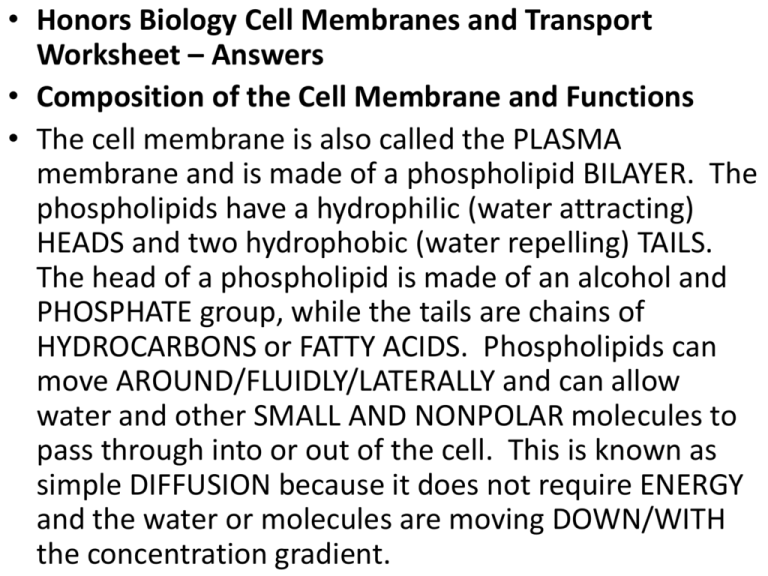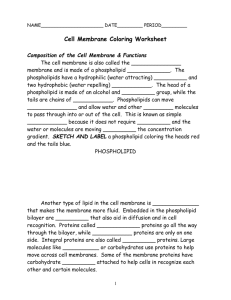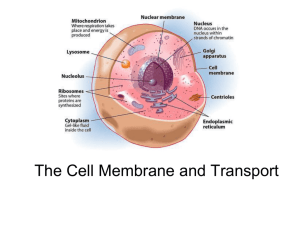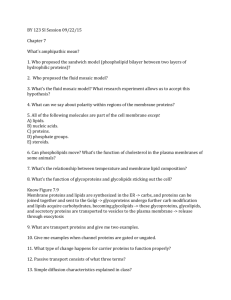Cells and Transport Worksheet Answers
advertisement

• Honors Biology Cell Membranes and Transport Worksheet – Answers • Composition of the Cell Membrane and Functions • The cell membrane is also called the PLASMA membrane and is made of a phospholipid BILAYER. The phospholipids have a hydrophilic (water attracting) HEADS and two hydrophobic (water repelling) TAILS. The head of a phospholipid is made of an alcohol and PHOSPHATE group, while the tails are chains of HYDROCARBONS or FATTY ACIDS. Phospholipids can move AROUND/FLUIDLY/LATERALLY and can allow water and other SMALL AND NONPOLAR molecules to pass through into or out of the cell. This is known as simple DIFFUSION because it does not require ENERGY and the water or molecules are moving DOWN/WITH the concentration gradient. Hydrophilic Hydrophobic • Embedded in the phospholipid bilayer are PROTEINS that also aid in diffusion and in cell recognition. Proteins called INTEGRAL proteins go all the way through the bilayer, while PERIPHERAL proteins are only on one side. Integral proteins are also called CARRIER or TRANSPORT proteins because they allow molecules to pass through the membrane. Large molecules like AMINO ACIDS or carbohydrates use proteins to help move across cell membranes. Some of the membrane proteins have CARBOHYDRATES attached to help cells in recognize each other and certain molecules. • • • • A = Phospholipid Bilayer B = Integral protein F = Fatty acid tails G = Phosphate heads • G = Attracts water • I = Helps maintain etc. • C,E,H = Involved in etc. H = Peripheral protein I = Cholesterol C = Glycoprotein E = Glycolipids F = Repels water A,F,G = Make up bilayer B = Help transport etc. • Osmosis and Tonicity • Osmosis is the diffusion of water across a semipermeable membrane. • With/Down • Isotonic = Same concentration as the other side • Hypertonic = Higher concentration than the other side • Hypotonic = Lower concentration than the other side • • • • • • • • • C - solution with a lower solute concentration A - solution in which the solute concentration is the same A or C - condition plant cells require A - condition that animal cells require C - red blood cell bursts (cytolysis) B - plant cell loses turgor pressure (Plasmolysis) B - solution with a higher solute concentration C - plant cell with good turgor pressure C - solution with a high water concentration • Labeling pictures left to right, top row first • Hypotonic Isotonic Hypertonic • Hypotonic Isotonic Hypertonic • Labeling beaker solutions (Isotonic, hypertonic, or hypotonic) and water direction (Out of cell, into cell, or in and out of cell equally) from left to right, top row first • Iso/Equally Hypo/In Hyper/Out Hyper/Out • Hypo/In Hypo/In Hypo/In Iso/Equal • • • • • • • • • • 1. Out 2. Into 3. Osmosis 4. Diffusion 5. higher; lower 6. Arrow should go right to left 7. Arrow should go left to right 8. Diffusion 9. Osmosis 10. From left to right, indicating arrow direction and whether the cell will expand or contract: • In/Expand Equal/Neither Out/Contract Out/Contract










